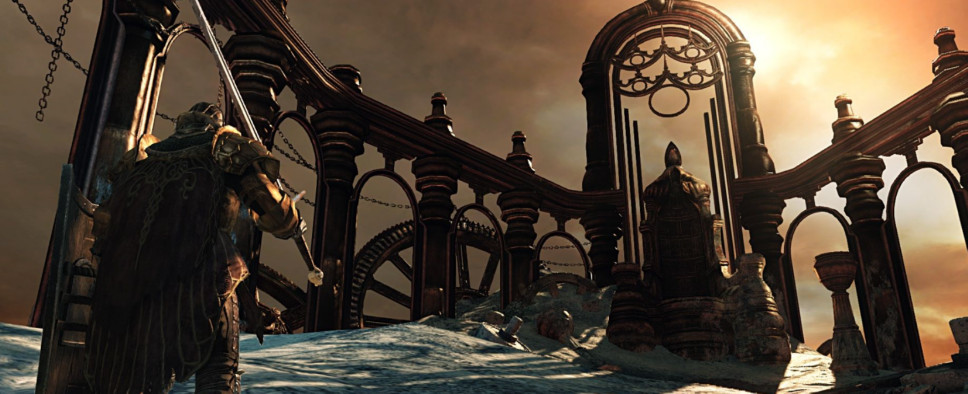Dark Souls II: Crown of the Old Iron King Review
-
Category: ReviewsHits: 10971

Article Index
The placement of the Ashen Idols can be quite clever, and I feel I also have to praise the way Smelter Wedges are placed into the level. At the beginning of the area a player is presented with six of them, which is a good amount but not enough to cover all the Ashen Idols found on a straight run to the Crown of the Old Iron King, let alone all of them. Of course, it's always possible to check optional areas for more wedges, as there are enough in the level to cover all of the idols, but it's also important to prioritize the idols that give immediate trouble, while leaving the others for a later, more thorough pass on the level. All that said, I can't help but be disappointed with the concept of the Ashen Idols itself. It's too on the nose and not nearly as organic and clever as Crown of the Sunken King's level design shifting switches, which also provided opportunities for the players to turn the tables in the midst of a battle. Some of the other traps in the level can be exploited in that way, but given the Ashen Idols are clearly meant to be the main "gimmick" of the DLC, I'd have preferred to see From Software go for something more flexible and inventive.
Overall, despite having some problems with it, I really enjoyed Crown of the Old Iron King's level design. The area feels even vaster and arguably more varied than the one featured in the previous DLC, the pacing feels spot on, and it all feels organic, even though the single room are starkly differentiated and many of them could arguably be considered "setpieces" in and of themselves.
Encounter Design and Bosses
While I'm forced to admit that hollow-like type enemies work in the Souls series, I really wish they weren't revisited again for Crown of the Old Iron King. Emaciated soldiers armed with axes, spears and longbows populate the DLC, especially in its early sections. Their movement set and statistics are slightly different (these ones are more mobile and their attacks are slightly slower) but after three games and three pieces of DLC, I can't help but groan every time I see a desiccated corpse of a soldier lumbering towards me with a stupefied expression on its dead face. As with the Sanctum soldiers in Crown of the Sunken King, these soldiers too are easy to deal with in a one-on-one fight, but tend to pose more problems when you encounter two or three of them, which happens fairly often.
Other enemy types are more inspired, and attempt, with varying degrees of success, to offer mechanical challenges that weren't present in the vanilla game. Giant headless demons that spew lava intermittently from their pauldrons are admittedly silly, but they're effective at forcing a player to consider positioning, and their lava affects enemies too, so their AI and special abilities can be exploited to create favorable opportunities. Possessed floating armors still ultimately resembled the hollow enemies too much to strike me as really memorable, but the inhuman, unpredictable way they move around and attack (they can even detach their arms to extend their range) made them more interesting to fight than I'd have suspected. There is also a type of slave hollows that run away from your character while carrying barrels of black powder. Hitting them with a melee weapon is suicidal, but they can be lured near enemies and made to explode with a simple hit of a firebomb or a fire arrow. I have to admit I felt bad every time I killed one, though, as they don't really look like they deserve it.
If I had to choose a single enemy type as my favorite though, there's really one that springs to mind, perhaps due to the way the first encounter with them is designed. Grotesquely crawling soldier with no legs are first encountered in a dark hallway where it's impossible to see more than a few feet in front of your character. At first sight they are not particularly scary: they have a lunging attack, but it can be easily avoided, and their movement speed is really slow. They do, however, become much faster when they're hit by fire, and that occurrence is far from rare. First of all, the braziers that you can use to illuminate the dark hallways these enemies are found in are completely coated with oil, so just standing in the proximity of a lit one inflicts fire damage. Needless to say, it's not a good idea to hide behind one of them while these foes are approaching. Furthermore, these enemies can also blow themselves up for massive damage, and they're spaced in such a way that they'll usually hit some of their friends, chipping away at their health but buffing their speed in the process.
It doesn't end there either: once you've dispatched the first group and descended a ladder to a small circular arena dotted with unlit braziers, an invader NPC spawns to attack you. Armed with a sword that she immediately buffs with fire damage, she can easily hit the braziers in the room, lighting them in the process. I found hiding behind these braziers was a good way to chip away at her health with fire damage, but I also was aware that, if any of those crawling enemies were in the vicinity of this room, they'd have plenty of opportunities to buff themselves with fire. Once I finally dispatched the red phantom NPC, I opened one of the many doors present in the room, and lo and behold: more of those crawling enemies. Not only was this a great way to rapidly introduce a series of mechanics and playing them off each other, but it also best exemplifies the encounter design philosophy for the entirety of the DLC.

